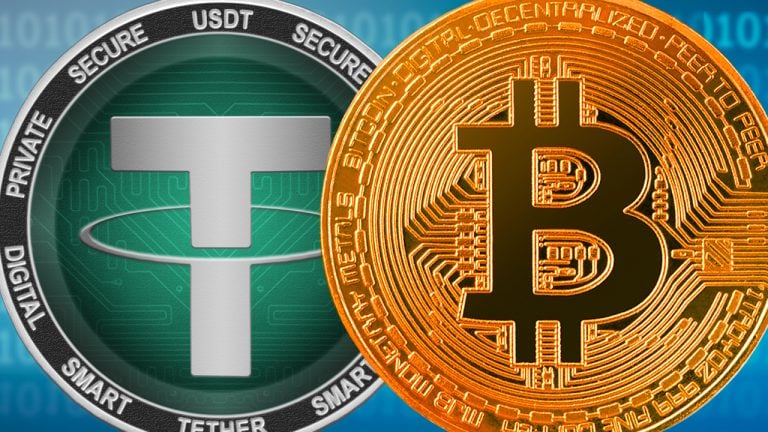 Onchain data reveals the stablecoin giant Tether has once again bolstered its bitcoin reserves, making an addition of 8,888.88 bitcoins to its wallet as of March 31. Tether’s Bech32 address now ranks as the seventh-largest holder of bitcoin by volume. Tether’s Latest Acquisition Puts Stash at 75,354 Bitcoin Though Tether has not officially confirmed its […]
Onchain data reveals the stablecoin giant Tether has once again bolstered its bitcoin reserves, making an addition of 8,888.88 bitcoins to its wallet as of March 31. Tether’s Bech32 address now ranks as the seventh-largest holder of bitcoin by volume. Tether’s Latest Acquisition Puts Stash at 75,354 Bitcoin Though Tether has not officially confirmed its […]
Tether’s newest reserve attestation shows the highest-ever percentage of cash equivalents, with most reserves consisting of U.S. T-bills and repurchase agreements.
The reserves for stablecoin issuer Tether contained approximately 86% cash and cash equivalents as of September 30, according to a new attestation report from accounting firm BDO. This is the highest percentage of cash and cash equivalents that have ever made up Tether’s reserves.
Tether today releases its attestation for Q3 /2023.- cash & cash equivalent portion of reserves is all time high at 85.7%, yielding ~$1B
— Paolo Ardoino (@paoloardoino) October 31, 2023
- US T-bill (direct and indirect) exposure at $72.6B
- reduced secured loans by $330M
- investments in energy, bitcoin mining and P2P tech… https://t.co/PXQ1H5gqUX pic.twitter.com/ibKJRPlBAg
According to the report, $56.6 billion worth of reserves are in U.S. Treasury bills with a maturity date of less than 90 days. Meanwhile, another $8.8 billion was held in reverse repurchase agreements involving these bills. There was $8.2 billion in U.S. Money Market funds pegged to $1 per note and $292 million in cash and bank deposits. Another $65 million is held in the form of treasury bills from countries other than the U.S.. The total amount of cash and cash equivalents is approximately $74 billion, which is 85.73% of Tether’s total reserves of $86.4 billion.
The report also shows that Tether has reduced its reliance on secured loans as a means of raising revenue. Secured loans now make up only $5.1 billion worth of USDT reserves, which is approximately $336 million less than what the previous report showed. Tether was criticized in September for continuing to make secured loans after previously stating that it would wind these down.
Related: Brazil’s USDT adoption soars in 2023, makes up 80% of all crypto transactions
In an accompanying blog post, Tether forecast a further reduction in loans by the close of day on October 31. An additional $1.1 billion in loans will be wound down by this date, at which point only $900 million in loans will remain as part of reserves.
BDO publishes attestations of Tether’s reserves every quarter, with a one-month lag between the end of the quarter and the publication of the report. Tether claims that it is working on a system to provide real-time audit reports in 2024.

The umbrella organization for Canada's securities regulators has set out conditions for the trading and issuance of stablecoins.
The Canadian Securities Administrators (CSA) has provided guidance to exchanges and cryptocurrency issuers on its interim approach to what it calls value-referenced crypto assets, with a particular focus on stablecoins.
On Oct. 5, the umbrella organization of Canada’s provincial and territorial securities regulators published a clarification saying it may allow trading of certain cryptocurrencies that reference the value of a single fiat currency, subject to terms and conditions.
In February, the CSA reaffirmed its view that stablecoins “may constitute securities and/or derivatives” which Canadian crypto exchanges are prohibited from trading.
However, if issuers maintain an appropriate reserve of assets with a qualified custodian and crypto exchanges offering stablecoins make “certain information related to governance, operations, and reserve of assets publicly available,” then the CSA could allow for those assets to be traded.
CSA Chair and Chair and CEO of the Alberta Securities Commission, Stan Magidson, said in a statement:
“This interim framework, which we will build upon in the future, sets certain standards to help ensure that investors receive the information they need about the assets they are purchasing, including the risks associated with them.”
The CSA cautioned that fiat-backed crypto assets satisfying the terms are still risky and should not be viewed as endorsed or risk-free.
Related: Canadian crypto ownership declines amid tight regulations, falling prices
In August, Cointelegraph reported that regulatory clarity in Canada has generated greater interest in crypto from institutions.
In July, the CSA issued guidance on staking stating that it was allowed but lending opportunities are limited and the proportion of “illiquid” assets is restricted.
Stablecoin market capitalization has been in decline over the past 18 months or so and is currently at $123 billion representing around 11% of the total crypto market cap.
Magazine: Should you ‘orange pill’ children? The case for Bitcoin kids books

Gold bars recently sold out at Costco, reflecting investors’ souring mood about the economy. Is there a silver lining for Bitcoin?
Costco has made headlines this week after it rapidly sold out of gold bars. In times of economic uncertainty and rising inflation, it's no surprise that investors are turning to traditional safe-haven assets like gold. The question is whether gold’s performance will eventually catapult its price above $2,050, a level last seen in early May.
In the past 12 months, the price of gold has surged by an impressive 12%. This rally has been partially fueled by the Federal Reserve's efforts to combat inflation by maintaining higher interest rates, a move that benefits scarce assets like gold. While gold's performance is commendable, it's essential to put it into perspective.

Over the same period, gold's returns have roughly matched those of the S&P 500, which saw a gain of 15.4%, and WTI oil, which increased by 12%. However, these gains pale in comparison to Bitcoin's staggering 39.5% rise. Still, it's important to note that gold's lower volatility at 12% makes it an attractive choice for investors looking to manage risk.
One of gold's strongest selling points is its reliability as a store of value during times of crisis and uncertainty. Gold's status as the world's largest tradable asset, valued at over $12 trillion, positions it as the primary candidate to benefit from capital inflows whenever investors exit traditional markets like stocks and real estate.

For example, at the height of the COVID-19 pandemic. In the 30 days leading up to March 24, 2020, gold only dipped by 2.2%.
According to data from Gold.org, central banks have been net buyers of gold for the second consecutive month, adding 55 tons to their reserves, with notable purchases by China, Poland and Turkey.
Bloomberg reported that Russia is planning to bolster its gold reserves by an additional $433 million to shield its economy from the volatility of commodity markets, especially in the oil and gas industries.

Taking a closer look at production figures, Visual Capitalist estimates that approximately 3,100 tonnes of gold were produced in 2022, with Russia and China accounting for 650 tonnes of this total. The World Gold Council also predicted that if gold prices continue to rise, total production could reach a record high of 3,300 tonnes in 2023.
One crucial metric to consider when evaluating gold's investment potential is its stock-to-flow ratio, which measures the production of a commodity relative to the total quantity in existence.
Related: Bitcoin price holds steady as S&P 500 plunges to 110-day low
Gold's stock-to-flow has remained stable at around 67 for the past 12 years. In contrast, Bitcoin has experienced three scheduled halvings, effectively reducing its issuance, and currently boasts a stock-to-flow ratio of 59. This suggests that Bitcoin has a lower equivalent inflation rate compared to the precious metal.
Bitcoin’s performance could surpass gold’s as the U.S. government approaches a shutdown due to reaching the debt limit, causing investors to seek alternative scarce assets. Bitcoin’s $500 billion market capitalization makes it easier for the price to jump even if its inflow is much smaller. Additionally, central banks could be compelled to sell their gold holdings to cover expenses, further boosting Bitcoin's appeal.
There's also the possibility of new gold discoveries. While gold remains a stalwart in the world of safe-haven assets, Bitcoin's impressive gains and lower equivalent inflation rate make it a strong contender for investors seeking alternative stores of value. Despite this, the ongoing economic uncertainty and the Federal Reserve's monetary policies will continue to benefit both assets.
This article is for general information purposes and is not intended to be and should not be taken as legal or investment advice. The views, thoughts, and opinions expressed here are the author’s alone and do not necessarily reflect or represent the views and opinions of Cointelegraph.

The Coinbase earnings report shows that services and subscriptions are the exchanges’ core revenue streams. Is this a positive or a negative?
Coinbase, a leading U.S. cryptocurrency exchange, shared its 2Q results on August 3. Despite showing a net loss, some positives emerged, like a 13% cut in operating expenses from the last quarter and a 3% boost in its cash reserves to $5.5 billion.

However, the exchange took a hit with a $97 million net loss, worse than its previous quarter, and saw a 32% drop in its adjusted EBITDA to $194 million in 2Q.
One downside was the 7% fall in subscription and service revenue from 1Q. The letter to shareholders revealed that a 28% decrease in the USDC stablecoin market cap partly caused this. Since Coinbase holds a stake in Circle, the USDC's issuer, they gain from the interest rate offered by the stablecoin reserves.
Additionally, customer fiat balances deposited at the exchange serve as another revenue source. But despite these, Coinbase's interest income fell by 16% from the last quarter to $201 million in 2Q.
Even so, the numbers suggest that Coinbase has successfully lessened its dependence on trading fees. Subscription and service revenues matched trading revenues in the first half of 2023, a shift more noticeable when you consider transaction costs consume about 15% of its revenues. This suggests that Coinbase has transitioned from a trading firm to a service broker, prioritizing recurring revenues.

Looking at Coinbase's (COIN) share price, there isn't a clear sign of this shift in focus throughout 2023. This suggests that either investors still firmly believe that trading fees will remain the key income driver for the company, or they simply haven't been crunching the numbers as diligently as they should.
It's impossible to accurately predict what direction the cryptocurrency market will take in the next few years, but one can certainly assess Coinbase's potential to ramp up its services and subscription revenues, independent of how trading fees pan out. There are several notable events on the horizon that could significantly cut the exchange’s reliance on trading.
The first is that Tether, the largest stablecoin by market cap, is eventually sued by DOJ and loses its banking partnerships. If the company issuing Tether were to be sued by the Department of Justice (DOJ) and consequently lose its banking partnerships, it could suffer a considerable loss in market cap. This scenario could create a massive opportunity for USDC to swoop in and fill the void. Because Coinbase enjoys revenue from Circle, the issuer of USDC, such a shakeup could potentially multiply Coinbase's service revenue by up to four times.
Second, Binance could be effectively shut down by regulators. Despite its stance as the reigning champion of cryptocurrency exchanges in terms of trading volume, Binance has been attracting attention from regulators worldwide, and not the good kind. If regulatory pressures were to effectively shut down Binance, this could pave the way for Coinbase to seize a substantial increase in market share. The knock-on effect would likely be a significant boost in service revenues for Coinbase.
Third, is the potential launch of Bitcoin spot ETFs in the United States because this could be a game-changer for Coinbase. The company has already entered into surveillance-sharing agreements with ETF issuers, and it's ready to provide custody services. This new avenue would create an additional source of revenue for Coinbase.
Lastly, it's important to remember that while Coinbase's current focus is on cryptocurrency trading and custody services, the company has plans to diversify and expand its product offerings. For instance, it's planning to launch a margin trading platform and a cryptocurrency lending platform. These new products and services have the potential to generate significant revenue from services and subscriptions.
The crypto landscape's volatility clouds judgment on whether Coinbase's pivot to non-trading revenues is the right call. But signs are showing that Coinbase is agile and adaptive, slashing expenses and fortifying its cash chest. They've managed to match subscription revenues with trading revenues, a clear indicator of this adaptability.
Related: Coinbase to file order seeking dismissal of SEC lawsuit
The billion-dollar question, however, is whether the investors will acknowledge and reward this shift in revenue generation. Currently, it seems that investors aren't paying adequate attention to Coinbase's strategic revamp but if some of the scenarios mentioned before come to life, they could be in for a pleasant surprise. It's a dynamic space, and this crypto giant seems to be playing its cards strategically.
This article is for general information purposes and is not intended to be and should not be taken as legal or investment advice. The views, thoughts, and opinions expressed here are the author’s alone and do not necessarily reflect or represent the views and opinions of Cointelegraph.

Tether has released its latest reserves attestation for USDT, with its excess reserves increasing to $3.3 billion.
Tether continues to increase its treasury reserve holdings backing circulating USDT (USDT) tokens, according to its latest financial attestation for the second quarter of 2023.
Tether Holdings published its Q2 attestation from accounting firm BDO, highlighting an $850 million increase in its excess reserves, which takes its total to $3.3 billion.
Tether Excess Reserves increase by 850M to reach $3.3B as Leading Stablecoin Reveals $72.5B overall exposure in US T-Bills and Unveils Energy-Related Investments.
— Tether (@Tether_to) July 31, 2023
Read more https://t.co/zoEHWMawEM pic.twitter.com/N4vk3EUQnw
The report also serves as the first time the company has disclosed its indirect exposure to United States Treasurys held by money market funds as well as U.S. Treasurys collateralizing its overnight repo:
“By aggregating them together, the amount of Treasuries backing Tether’s stablecoins is about $72.5B.”
Speaking to Cointelegraph at Money2020 in Amsterdam in June, Tether chief technology officer Paolo Ardoino revealed that Tether’s US Treasury bill holdings were equivalent to the amount held by sovereign nations like Mexico.
Tether has looked to allocate company profits to build up excess reserves in the wake of the collapse of FTX and bankrupt cryptocurrency lending firms like Three Arrows Capital. The excess does not include the 100% reserves that Tether maintains to redeem circulating USDT tokens.
Related: Tether’s game plan in El Salvador: Why invest in Volcano Energy?
Ardoino said that industry players that have undercollateralized assets or operations have created weak points in the wider cryptocurrency ecosystem, which has driven its decision to allocate shareholder profits to building a large excess reserve.
“We believe that open communication and strong financials foster trust and reliability, and this is what the global community deserves especially in a year devastated by many failures across the banking and crypto industry.”
Tether tipped its operational profits at $1 billion from April to June 2023, accounting for a 30% increase from Q1 2023. The improved quarterly performance also reflects a general surge across the cryptocurrency markets that was driven by the recent consolidation of Bitcoin (BTC) around the $30,000 mark.
The 2023 Q2 report also notes that 85% of Tether’s reserves are held in “liquid” investments of cash or cash equivalents. Tether’s latest reserve attestation estimates its total assets at $86.4 billion. Tether’s outstanding liabilities in relation to circulating USDT tokens are estimated at $83.17 billion.
The Q2 report also discloses that Tether’s shareholders will carry out a $115 million share buyback to “strengthen” its group. Profits from the second quarter have also been directed to “other investments in energy-related initiatives.”
The company notes that energy-related initiatives are not included in its attestation report, as it does not consider the investment as a suitable reserve for circulating tokens.
Cointelegraph has reached out to Tether to clarify whether this specific investment refers to its recently announced $1 billion investment in El Salvador’s renewable energy project
Magazine: ‘Elegant and ass-backward’: Jameson Lopp’s first impression of Bitcoin
 Tether, the stablecoin enterprise, has revealed its intention to devote 15% of its profits to bitcoin. The firm’s announcement comes on the heels of Tether’s recent attestation report, which emphasized the company’s possession of bitcoin reserves worth $1.5 billion. Tether’s Strategic Shift: Profits to Fuel Bitcoin Acquisition Tether, the company behind the crypto economy’s largest […]
Tether, the stablecoin enterprise, has revealed its intention to devote 15% of its profits to bitcoin. The firm’s announcement comes on the heels of Tether’s recent attestation report, which emphasized the company’s possession of bitcoin reserves worth $1.5 billion. Tether’s Strategic Shift: Profits to Fuel Bitcoin Acquisition Tether, the company behind the crypto economy’s largest […]
The world’s second-largest stablecoin issuer wants to reduce its exposure to potential US debt defaults.
Stablecoin issuer Circle has reportedly adjusted its reserves treasury in an effort to reduce the risks of United States debt defaults.
According to a May 10 Politico newsletter, Circle CEO Jeremy Allaire said that the firm has adjusted the mix of reserves backing its USD Coin (USDC) by switching to short-dated U.S. Treasuries to avoid getting caught up in a potential US debt default.
He said that the firm no longer holds Treasuries maturing beyond early June because it wants to avoid debt exposure.
“We don’t want to carry exposure through a potential breach of the ability of the U.S. government to pay its debts.”
The Blackrock-managed Circle Reserve Fund shows that current holdings mature no later than May 31.

Earlier this week, Treasury Secretary Janet Yellen said the government will be forced into making “decisions” if Congress doesn’t raise the federal debt limit.
U.S. President Joe Biden and Republicans are conflicted over raising the $31.4 trillion borrowing limit. The $24 trillion Treasury market and global financial system would be rattled if the country defaulted on its debts.
Rival stablecoin issuer Tether claims a majority of its reserves are invested in Treasury Bills with an average maturity of fewer than 90 days.
The firm stated that it has been “working to take steps to reduce its reliance on pure bank deposits as a source of liquidity,” according to a May 10 quarterly assurance report.
Related: Concern over banking crisis reaches levels unseen since 2008 — Poll
USDC supply has been shrinking over the past year, falling by 46% since its all-time high of $56 billion in June 2022. This has caused its market share to fall to 23% with a circulation of $30 billion. The beneficiary has been rival Tether as its market dominance has increased to 62% with a circulation of $82 billion USDT.
In April, Allaire blamed America’s war on crypto and the impending banking crisis for its dwindling market capitalization.
Cointelegraph reached out to Circle for further details but had yet to hear back at the time of publication.
Magazine: Unstablecoins: Depegging, bank runs and other risks loom

The financial advisory and accounting firm also revealed that Tether held roughly $3.4 billion worth of precious metals.
BDO Italia's latest attestation report for Tether revealed that Bitcoin (BTC) made up approximately $1.5 billion of the stablecoin issuer's reserves, or roughly 2% of the total, at the end of the first quarter. The accounting firm did not list Bitcoin as a line item in previous reports.
Without much fanfare, Tether has started reinvesting some of their profits/excess reserves into Bitcoin. How much have they acquired in Q1, you ask? Just around 52,670. pic.twitter.com/NI3N0oICOz
— girevik (@girevik_) May 10, 2023
Precious metals were also given their own line item in the report, revealing that Tether holds around $3.4 billion worth of the assets, or approximately 4% of total reserves.
In an accompanying announcement, Tether said it included information about its Bitcoin and precious metals holdings to provide increased transparency to holders of the USDT stablecoin:
“The CRR provides for the first time, additional categories with the aim of increasing transparency into Tether’s reserves reporting. Physical gold, Overnight Repo, Corporate Bonds and Bitcoin ownership have been reported separately.”
The announcement also stated that Tether made $1.48 billion in profits over the course of the first quarter and increased the circulation of its coin by 20%. Because of this increased circulation, Tether’s total reserves have reached their highest point ever, at approximately $81.8 billion.
Tether’s newest growth may have been partially caused by the decline of its largest competitor, Circle’s US Dollar Coin (USDC). USDC briefly depegged in the secondary market in March due to concerns about its exposure to the failed Silicon Valley Bank. The coin regained its peg quickly, but its market cap has declined ever since. Circle CEO Jeremy Allaire has cited an alleged U.S. regulatory crackdown on crypto as another factor for its recent decline.
 Welcome to Latam Insights, a compendium of the most relevant crypto and economic development news from Latin America during the last week. In this issue, Bolivia passes a law to sell gold for dollars, the Central Bank of Argentina bans fintech companies from using crypto, and Fitch improves El Salvador’s credit rating. Bolivia Passes Law […]
Welcome to Latam Insights, a compendium of the most relevant crypto and economic development news from Latin America during the last week. In this issue, Bolivia passes a law to sell gold for dollars, the Central Bank of Argentina bans fintech companies from using crypto, and Fitch improves El Salvador’s credit rating. Bolivia Passes Law […]